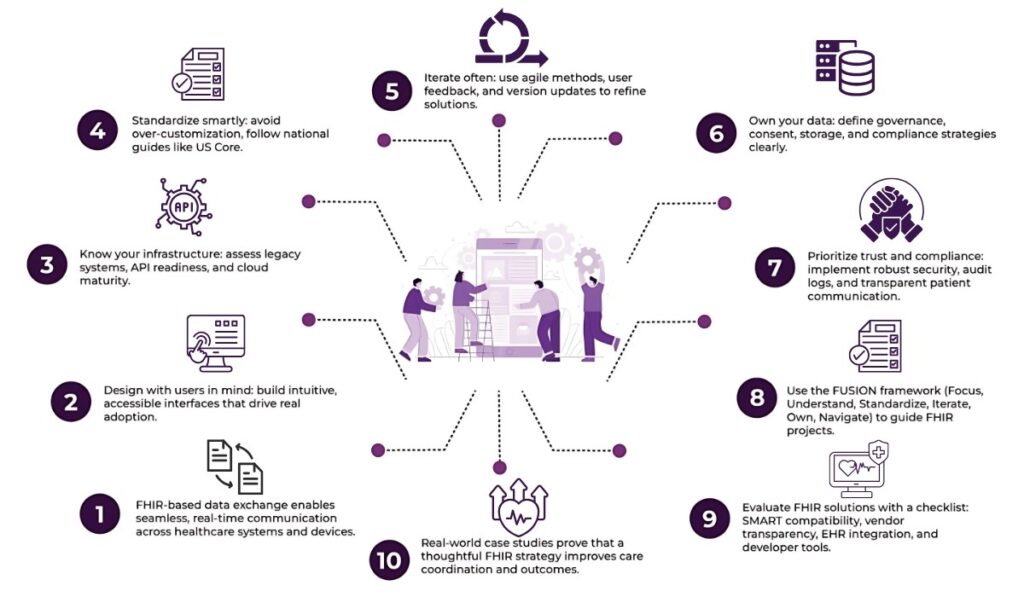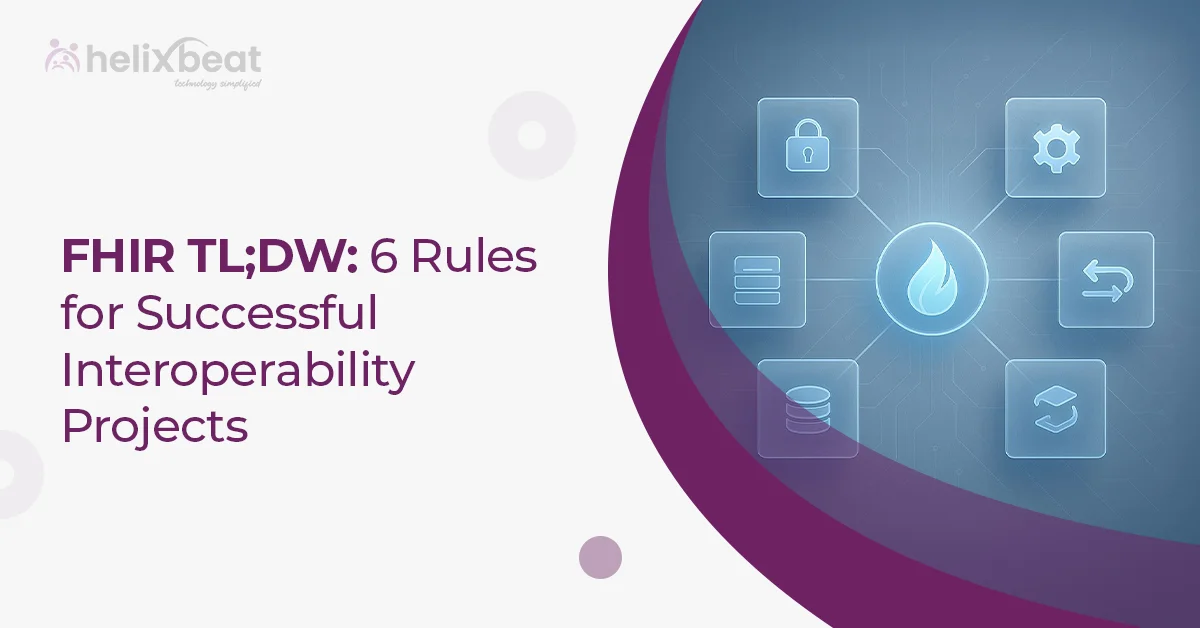Imagine a world where patient records flow effortlessly between hospitals, clinics, and apps—no more fax machines, no more repeated tests, no more fragmented care. That’s the promise of FHIR (Fast Healthcare Interoperability Resources). But turning that promise into reality requires more than just adopting a standard—it demands strategy, alignment, and a user-first mindset.
Whether you’re just beginning your FHIR journey or scaling up an existing project, success hinges on more than APIs. In this blog, we’ll walk you through six essential rules—aligned with the FUSION framework—to help you build meaningful, secure, and future-ready interoperability solutions.
In this blog, we’ll decode FHIR rules for successful interoperability projects in your healthcare

Table of Contents
Rule 1: Focus on the User Experience (F)
Interoperability isn’t about systems talking to each other; it’s about people using data effectively. The first step in a successful FHIR project is designing for users—clinicians, patients, and administrators. Many healthcare apps and APIs fail because they dump data without context or usability. FHIR gives you structured resources, but it’s up to your team to present them meaningfully.
Take the example of a hospital that implemented FHIR APIs to display lab results. Initially, adoption was poor. Clinicians found the layout confusing and unfamiliar. After redesigning the UI to mimic the format of the existing EHR, usage increased dramatically. The data was the same, but the experience changed.
Incorporate intuitive dashboards, filter options, visual cues, and mobile-friendly designs. Engage users early and often in the development process. A user-first FHIR strategy means fewer support tickets, higher adoption, and real-time impact on care delivery.
Rule 2: Understand the Infrastructure (U)
FHIR isn’t plug-and-play. Underneath every API call is a complex web of systems, workflows, and legacy constraints. To integrate FHIR effectively, providers must understand their current IT environment. Which EHRs are in use? Are there custom-built databases? What’s the level of cloud readiness?
For example, a small clinic using a homegrown EMR realized a full overhaul would be costly and disruptive. Instead, they adopted a lightweight FHIR middleware that extracted, mapped, and shared selected data fields with a regional health information exchange (HIE). It wasn’t flashy, but it worked.
Infrastructure readiness also includes understanding bandwidth limitations, API security, and downtime contingencies. Evaluate whether your current system supports FHIR STU3 or R4. Don’t forget to factor in authentication protocols like OAuth 2.0 and OpenID Connect.
A strong infrastructure plan minimizes project delays and ensures a solid foundation for future scalability.
Rule 3: Standardization with Purpose (S)
FHIR provides a vast library of resources and profiles. The temptation to customize everything is high, but unnecessary extensions create long-term compatibility issues. Interoperability thrives on standardization.
Consider a case where two hospitals tried to share patient allergy data. One used a custom extension that added an internal code. The other stuck to the US Core FHIR AllergyIntolerance resource. As a result, integration failed until they agreed to standardize their profiles.
That said, there are valid reasons for customization, especially for specialty care or research data. The key is to extend thoughtfully and document rigorously. Stick to HL7-sanctioned profiles when possible, and align with national guidelines (e.g., US Core, IPS).
Standardization doesn’t mean rigidity. It means choosing uniformity where it adds value—saving time, reducing confusion, and improving cross-system compatibility.
Rule 4: Iterate with Feedback (I)
FHIR is a journey, not a one-time implementation. Don’t aim for perfection in the first release. Instead, start small, deploy, get feedback, and improve. Agile principles are your friend.
One healthcare network released a beta version of their FHIR patient access app. Within weeks, patients reported that lab results were hard to understand, and some terminology was too technical. The team quickly updated the interface, added plain-language summaries, and relaunched with improved satisfaction.
Involve users from day one. Run pilot programs, host usability labs, and open feedback channels. Post-launch, monitor API usage patterns, error logs, and drop-off points.
Iteration also allows teams to respond to updates in FHIR versions or security protocols. Don’t treat your FHIR implementation as “done”; treat it as a product that’s always evolving to meet user needs.
Rule 5: Own Your Data Strategy (O)
FHIR is not a data strategy—it’s a data transport standard. Providers must still define how data is stored, governed, accessed, and retired. Who owns the patient data? How is consent captured? Where are the backups?
A progressive healthcare group rolled out FHIR APIs but noticed confusion around data permissions. They soon integrated a SMART on FHIR app to handle patient login, authentication, and consent management. This created a smoother, compliant, and transparent experience.
Develop policies around data quality, duplication handling, data lineage, and audit trails. Be clear on which data sources are authoritative. Align with HIPAA, GDPR, and local policies.
Owning your data strategy empowers your team to make confident decisions about interoperability, rather than relying solely on vendors.
Rule 6: Navigate Compliance and Trust (N)
No interoperability project succeeds without trust. Patients must trust that their data is safe. Providers must trust the systems they’re exchanging data with. Compliance isn’t just legal—it’s ethical.
A telehealth provider built a powerful FHIR-based exchange to deliver summaries to primary care physicians. But before going live, they paused to build in robust encryption, role-based access controls, and detailed audit logging. The extra time paid off—their implementation passed external audits and earned patient confidence.
HIPAA and local regulations should be part of every design discussion. Adopt security best practices such as TLS, OAuth 2.0, access tokens, and session expiries. Build patient-facing interfaces that explain how their data is used.
Interoperability, at its heart, is about collaboration. And collaboration only happens when people feel secure.
Choosing the Perfect FHIR Solution: A Checklist for Providers
Selecting the right FHIR (Fast Healthcare Interoperability Resources) solution goes beyond ticking off technical specs—it’s about finding the perfect fit for your organization’s culture, infrastructure, and long-term care goals. With interoperability driving value-based care, your FHIR solution must align with the FUSION values: Flexibility, Usability, Standards, Integration, Outcomes, and Navigation.
Here’s a quick but powerful checklist to help providers choose wisely:
1. SMART on FHIR Compatibility
Does the solution support SMART on FHIR for launching third-party apps inside the EHR? This ensures seamless clinician workflows and patient engagement tools. A chronic care app, for instance, can pull real-time vitals directly into a patient’s dashboard using SMART protocols—enabling truly connected care.
2. Compliance with Implementation Guides
Make sure the solution supports national guides like US Core or Da Vinci. These define how FHIR should be implemented for specific use cases like Prior Authorization or Quality Reporting. Without this support, you’re risking poor interoperability—even if the vendor claims to be “FHIR-compliant.”
3. Responsive & Transparent Vendor
Interoperability is an evolving journey. Choose a vendor that offers clear support SLAs, shares a public roadmap, and is open about timelines. A transparent vendor becomes a long-term partner—not just a tech provider.
4. Sandbox Testing
A test environment is essential to simulate real-world use cases before deployment. For example, testing a new patient portal with synthetic data ensures your team can catch bugs or optimize flows—before patients are ever affected.
5. EHR Compatibility
Whether you’re on Epic, Cerner, or Meditech, your FHIR solution must integrate smoothly. Look for existing case studies, client references, and pre-built connectors for your EHR to avoid costly workarounds.
6. Developer Tools & Documentation
A great FHIR platform empowers your team. Evaluate if the vendor offers SDKs, clear documentation, and code samples. Good tools reduce development time and help your team innovate faster.
Case Study: Riverside Health Network’s FHIR Success
Riverside Health Network struggled with fragmented care and slow record sharing. Instead of a costly EHR overhaul, they adopted a SMART on FHIR solution that integrated into their existing Epic system. By prioritizing user experience, aligning with US Core standards, and using FHIR middleware, they enabled seamless data sharing across departments. An iterative rollout with real-time feedback improved adoption. With secure OAuth 2.0 access and clear patient consent workflows, trust and compliance were ensured. Within 9 months, care coordination improved, referral delays dropped 35%, and clinician satisfaction rose—proving FHIR works when implemented with purpose.
Final words,
Successful FHIR implementation isn’t just about checking technical boxes—it’s about creating seamless, secure, and scalable experiences for patients, clinicians, and administrators. By following the six FUSION-aligned rules and using the FHIR solution checklist, healthcare providers can ensure their interoperability projects drive real-world outcomes.
Focus on usability, infrastructure readiness, standardization, continuous iteration, data governance, and compliance to build trust and resilience into your digital health ecosystem. Choose a solution that grows with your goals and empowers innovation at every step. Interoperability isn’t a destination—it’s a strategy, and FHIR is your most powerful tool on that journey.
FAQs
1. What is FHIR, and why is it important for healthcare interoperability?
FHIR is an HL7 standard designed to enable the electronic exchange of healthcare information. It facilitates seamless data sharing across different healthcare systems, enhancing interoperability and improving patient care.
2. How does SMART on FHIR enhance application integration with Electronic Health Records (EHRs)?
SMART on FHIR provides a standardized framework that allows applications to securely integrate with EHR systems. It utilizes open standards like OAuth2 and OpenID Connect to enable third-party apps to access EHR data, enhancing functionality and user experience.
3. What are the key considerations when implementing FHIR in existing healthcare IT infrastructure?
When integrating FHIR, it’s crucial to assess current IT infrastructure compatibility, ensure adherence to relevant implementation guides (such as US Core), and prioritize data security and patient consent protocols. Engaging stakeholders early and adopting an iterative development approach can also facilitate smoother implementation.
4. How can healthcare providers ensure compliance with FHIR standards and regulations?
Providers should stay updated with the latest FHIR versions and implementation guides, align with national and international interoperability regulations, and conduct regular compliance audits. Utilizing tools like FHIR servers and profilers can aid in maintaining standard compliance.
5. Are there specific tools or resources to facilitate FHIR adoption?
Yes, various tools can assist in FHIR adoption, including FHIR servers for data management, terminology services for handling coding systems, and mapping tools for data transformation. Platforms like the Kodjin Interoperability Suite offer comprehensive solutions for effective FHIR implementation.














